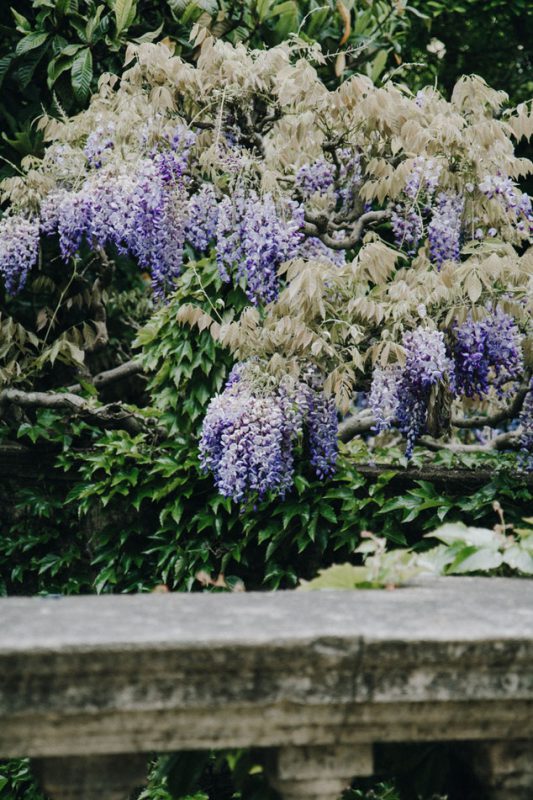Beautiful climbing plants or vines can give your whole yard, or house an organic and inviting feel, like stepping into a green room. They can also hide a broken-down fence or add charm to a brick exterior that seems too austere. There is something special about coaxing a vine up onto your brick walls or to cover an old fence with a gorgeous climbing plant.
We have included a list of our favorite climbing plants to make your yard a beautiful getaway or secret garden.
Wisteria
Wisteria is one of the most colorful climbing plants with a beautiful scent. It comes in shades of white, purple, pink, and blue and is native to China, Japan, and the Eastern U.S.
Wisteria needs full sunlight or partial shade to do best and soil with good drainage. Wisteria blooms in the spring. If you’ve bought a tree or planted from cuttings, it will be 3-4 years before you will see any blooms. Planting wisteria from seed requires even more patience, as it will take even longer to flower.
Climbing Roses
Climbing roses are the dream of many ambitious gardeners. We’ve all been to that perfectly cultivated rose garden with the arch of climbing roses. Something like that is a showstopper. It might be very well worth all the time spent in making it happen.
Climbing roses don’t bloom right away, unlike other varieties. They need to be allowed to grow to full size. Train them with plastic wrapped wire ties and stakes to make sure the ties hold up against the elements. Pruning should be done in the dormant period from December through February. Another important thing to note is that you should fan out the canes instead of letting them overlap. This will leave space for new growth.
Rubens
This Clematis variety is your ticket if you are looking for a more rapid growing variety of climbing plant. It yields many flowers in late spring or late summer, so be prepared.
Rubens do best when planted in the shade and allowed to climb into a sunlit area. Plant rubens in moist but well-drained soil. Fertilize in the spring with organic compost and add a general fertilizer. Rubens can grow quite tall if you take care of them – up to 26 feet!
Climbing Hydrangea
Another plant which can stand alone or be taught to climb is this angelic-looking flower with large leaves and puffy blooms. Plant climbing hydrangea plants in early spring or fall. Summer is hard on a hydrangea because of its high need for water.
To establish the roots, this plant will need tons of water. It’s important to plant your hydrangea in a place that gets good drainage but is not too wet. Its roots are susceptible to rot.
Climbing hydrangeas are also easily damaged, so they need to be planted in a more protected area – a courtyard or fenced-in garden could be the perfect place. This is especially important if they have natural shelter from the walls and aren’t sitting in hot sun for too long. Climbing hydrangeas can grow for many years without needing to be pruned.
Morning Glory
Morning glories are fast growing and avid climbers. Because of this, and because they can tolerate poor, dry soils, some morning glory varieties are used for creating shade on buildings where none exists. They can keep the building cooler inside.
Some morning glory species are very invasive and can take over any other type of plant, gobbling up the sunlight and nutrients for themselves. They produce pretty, cone shaped flowers. Depending on the species, some morning glories are planted as annuals and some can tolerate cold and be a perennial. Plant morning glory plants in full sun, moist well-drained soil and water on hot days to avoid wilting.
Jasmine
Another climbing plant people associate with the Orient is Jasmine. It comes in two varieties summer jasmine and winter jasmine. Summer jasmine does best on the south or southwest side of your home with full sun. Winter jasmine can be planted in partial shade on the south, east or northwest side of your home.
Jasmine is a woody climber in the olive family. It thrives in a subtropical and warm temperate climate and needs frequent watering. Jasmine is also cultivated for its large, fragrant, and beautiful flowers. Summer jasmine needs to be pruned in late summer or early autumn and winter jasmine needs to be pruned only in spring. All Jasmine can grow up to 26 feet in both height and spread.
Climbing plants can be some of the most rewarding plants for the effort you put in. They can turn your yard into that dreamy secret garden.



